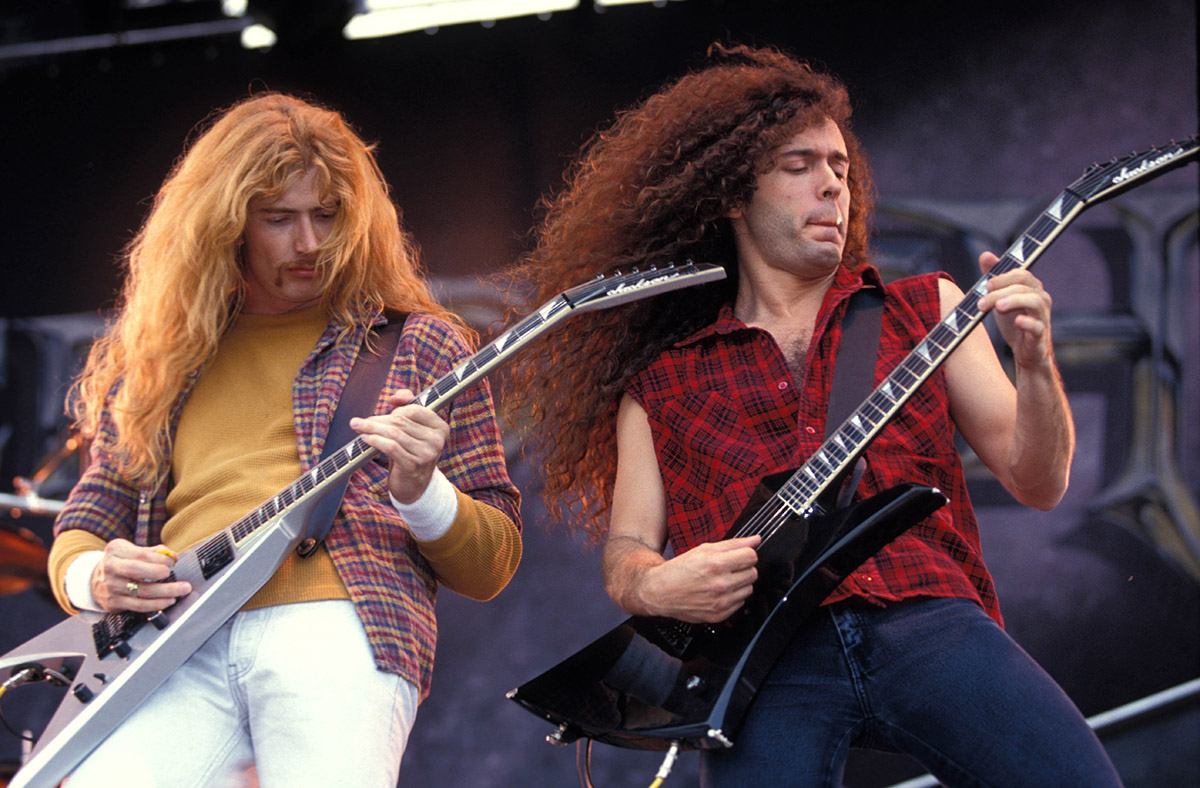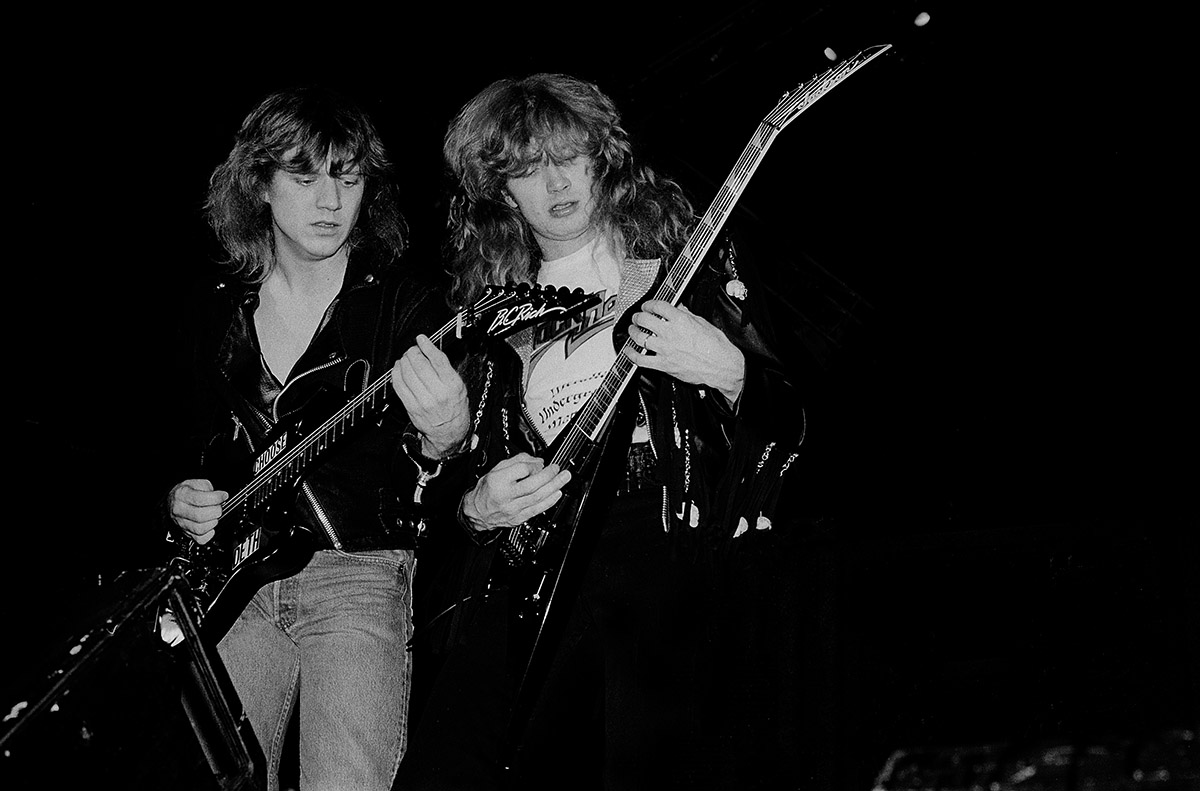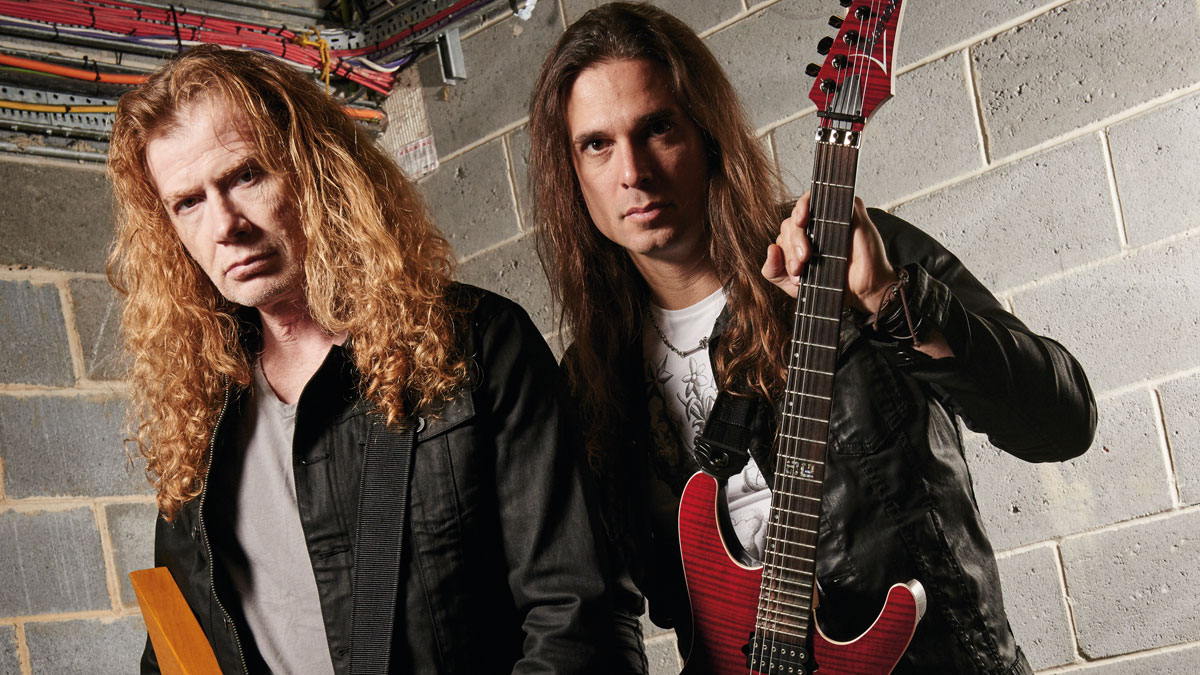5 songs guitarists need to hear by… Megadeth
How Dave Mustaine and his rotating cast of elite lead players made Megadeth the original state-of-the-art thrash band

Megadeth were formed in 1983 by a most incandescent Dave Mustaine. Sure, most young metalheads have a belly full of fire but Mustaine had an axe to grind. The year had been pretty rough on him.
He had just been ousted by Metallica, an inciting event that would shape his musical endeavours for the decades to come, with the episode taking on the mythical quality of a superhero origin story. A burning desire for revenge and barely concealed one-upmanship serviced the magma at Mustaine’s core 24/7, and he was quick to let it out.
Mustaine’s temper would come in handy, like when he first met long-time bassist and co-collaborator David Ellefson after throwing a plant pot at his then neighbour’s apartment in complaint at the noise. Soon after they found common purpose, with Ellefson proving a more than capable wingman whose flat-picking bass style jived nicely with Mustaine’s kinetic guitar arrangements.
It was no surprise that Megadeth turned out as they did; hyper, self-destructive, relentless. Mustaine’s talents with the electric guitar lean towards the animalistic and spectacular, and he has displayed the canny knack of finding the right lead guitar player at the right time.
Over the years he has cast the net wide. Some, such as Kerry King, were pinch hitters. In 1984, King played four shows with Megadeth before Slayer became official and set about carving their own name into the long arm of heavy metal history. Mike Albert was another, filling in on tour in ’85 for Chris Poland.
All in all, Mustaine has welcomed 11 guitar players to the Megadeth alumni, and Megadeth has never sounded so good as when Mustaine’s lead guitar foil had a totally different style.
Take Chris Poland, who had superhuman legato, the origin story of which was a childhood accident that severed tendon in his fretting hand's index finger. As an adult, it give him a slippery style, too quick for the human ear to parse, throwing in chromatic passing notes and stinging vibrato.
Get the MusicRadar Newsletter
Want all the hottest music and gear news, reviews, deals, features and more, direct to your inbox? Sign up here.
Or Marty Friedman, whose reputation as a premium shredder was already consecrated by his work with Jason Becker in Cacophony, before joining Megadeth in 1990 and applying his Exotic Metal Guitar style to Mustaine’s breathtaking compositions.
Others, such as Jeff Young, Glenn Drover, Chris Broderick, and the present incumbent, Kiko Loureiro, have all served as super-capable six-string lieutenants. You can chart Megadeth’s evolution by their time spent in the band, and hear it in the influence they had on Mustaine’s songwriting and playing. Speaking to MusicRadar in 2015, Mustaine spoke of this gift for finding new talent.
“We’ve had this uncanny knack for falling upwards whenever there’s been eruptions to business with our line-up,” he said. “Like when someone quits, gets fired or there’s a family emergency, we always seem to come out of it better. What I’m most excited about is fans seeing Kiko Loureiro play, because not many people are aware of his incredible talent.”
Unusual among metal bands, whose early work is often their most convincing, Megadeth took a little time to hit their stride. Their debut, Killing Is My Business… And Business Is Good, released in 1985 through Combat records, was chaotic and ambitious.
Mustaine immortalised his Metallica beef on tape with Mechanix. The song dated back to his time in Panic, before hooking up with James Hetfield et al, but was reworked by Metallica for The Four Horsemen and used on Kill ‘Em All. Of course, Mustaine’s Mechanix was faster.
Finding five Megadeth songs of special interest to guitarists is a fool’s errand. The sin of omission is clearly too great.
All but the guitar-less Dawn Patrol could be included from their 1990 thrash metal tour de force, Rust In Peace. Take No Prisoners offers a textbook example of a frantic rhythm figure retaining the gift of groove. Tornado Of Souls is a solid-gold classic. Stick Rust In Peace on shuffle and eight out of nine times you’ll land on some action.
Then there’s In My Darkest Hour, from So Far, So Good... So What! (1988), a track that proved Mustaine knew the value of restraint when the song called for it. The Conjuring – from Peace Sells… But Who’s Buying (1986) – is quite possibly Megadeth’s heaviest moment on record, and is animated by a sense of dark theatre and ritual.
Mustaine has retired the song from the set, insisting the thematic content – black magic, sorcery – is incompatible with his Christian beliefs. More’s the pity. Or maybe not. Maybe it makes picking the setlist easier. If only we could use the same rationale.
1. Holy Wars… The Punishment Due (Rust In Peace, 1990)
When it comes to understanding Megadeth’s capabilities and aesthetic constitution, Holy Wars… is the Rosetta Stone. Recorded in 1989 with producer Mike Clink – hired on the strength of his work on Guns N' Roses' Appetite For Destruction – Rust In Peace is the alpha and omega, the very acme of Mustaine’s widescreen songwriting. Megadeth had threatened to write songs like this before but only now had the stars aligned and they found the means, the chops and the vision to do so.
Here, Mustaine takes an intractable conflict as the subject matter, stirs up a hornets’ nest of riffs to open the jam, accelerating towards the grandeur of the middle section, which is of course introduced via a Marty Friedman nylon-string set piece for a Moorish/Spanish flourish.

This mid-section then features some of Friedman’s most tasteful note choices, complementing the chords underneath, before a syncopated natural harmonic riff comes up like blips on a radar screen as we head for an extended denouement in which Mustaine and Friedman trade solos, echoing the melodies introduced at the start of the song, and build towards a climax.
The structure of the song even echoes the thematic content, the mid-section partitioned by aggression on either sides. Nowhere has Mustaine/Friedman dynamic been more complementary than on here, and to think that Friedman had to push for a second pass at some of the solos.
Rust In Peace remains a foundational release for metal. Hitherto, the guitar solo was just a power up. But Holy Wars… demonstrated how the appliance of avant-garde shred, of exotic scales and unorthodox phrasing, could be used to elevate a thrash metal composition into something more grand, something more musically daring.
And there’s an ellipsis in the song title. Everything Megadeth is in here.
2. Hangar 18 (Rust In Peace, 1990)
Picking up where Holy Wars… left off – quite literally, it’s track two on the record – Hangar 18 anticipated the success of The X-Files as Mustaine plays Fox Mulder and unspools a paranoid fantasy of governmental coverups, alien autopsies and the extra-terrestrial fauna found in the warehouse spaces of Wright-Patterson Air Force Base, Ohio – an important locale for those tuned into the fevered conspiracies of Roswell 1947.
Again, it is musically audacious, if a little more formally conventional. The opening chord progression is identical to Metallica’s The Call Of Ktulu, only delivered as eighth notes at 161bpm.
Kudos to Ian Christe, publisher at Bazillion Points Books, for zooming out on the influence and noting that the same ascending chord progression was used in the chorus to Hey Bulldog by The Beatles, proving that no matter what corner of the musical subculture you find yourself, it all goes back to Liverpool and Lennon/McCartney.
A pedal-point riff on D, the verse is an all timer; sacrificing some bass note heaviness for tension proved a worthy trade-off. Besides, Ellefson holds it down here, locking in with the late Nick Menza’s drum pattern. The solo is where this mystery jumps off. If songwriting is storytelling, the verse and chorus feels like the setup with the big reveal coming at the solos. Again, Friedman takes the path less trodden for his note choices.
It would be a leitmotif of Friedman’s time in Megadeth. He had a second sight when it came to using the Phrygian-dominant, harmonic minor and Aeolian modes to hack into the emotional arc of Mustaine’s songwriting and broaden its canvas. Perhaps Tornado Of Souls was his high-water mark. No Friedman solo is better. But we are assuming that once you’ve pressed play on Holy Wars… you’ll make it to the end of the album anyway.
3. Good Mourning/Black Friday (Peace Sells… But Who’s Buying?, 1986)
Let’s take it back a few years to Mustaine’s partnership with Chris Poland and an album that many Megadeth fans would consider a close second to Rust In Peace.
Opening with Wake Up Dead, a spiritual antecedent of Rust In Peace’s Lucretia, Peace Sells is a consistently spectacular record that sees Mustaine et al take more stylistic risks than most of their peers ever dared to. Take the title track, with its propulsive pseudo-disco beat and Ellefson’s bassline establishing a solid groove for some primal boogie from a cynical Mustaine.
Good Mourning/Black Friday was another swing for the fences. If Mustaine as guilty of chasing hits in the post-Youthanasia era here he seemed to be actively resisting any constraints on his songwriting.
This is Mustaine’s imagination running wild, with the extended “Good Mourning” intro section written in the emotional dream cadence of A Nightmare On Elm Street movie. There’s something soft-focus about Mustaine’s arrangements here, the acoustic, the all-but-liquid melodic lead guitar from Poland, the reverb and the chorus. Hey, it was 1986.

Again, it’s another bipolar arrangement, a song jammed together from two? Either way it takes a 180-degree turn into some of Mustaine’s most well-executed thrash rhythms.
Substance abuse might have been wreaking havoc but the music held together. Sometimes if the material is strong enough, the record will make it through intact, even if the band did not. Samuelson and Poland left the band soon after, Poland returning in 2001 to drop some solos on The System Has Failed.
Just listen to how Mustaine builds the tension towards the second half of the song before Gar Samuelson’s drum tag drags us into the pit, where a really mean riff awaits.
All things considered, Peace Sells is Megadeth’s heaviest album, with Wake Up Dead, The Conjuring, Devil’s Island and the “Black Friday” section here all alive with a sense of danger that Mustaine – and his peers – found so hard to summon for most of the 2000s.
4. Fatal Illusion (Dystopia, 2016)

Kiko Loureiro’s Megadeth debut pulled Mustaine out of whatever creative funk had seen him make some questionable choices, most notably on Super Collider. After all, it sure does help when you employ one of the most gifted guitar players of his generation. The spiritual uplift from such positive HR practices is instantly recognisable on Dystopia.
In the grand reckoning of the Megadeth discography, Dystopia might not make the podium, but it has Mustaine rolling the clock back, playing the role of paranoid android in a society where we are watched 24/7 by big tech and who knows who else.
All that sort of thing is grist for the Mustaine mill, and he leans into it here, reanimating the machine. The intro even sounds as though he is trying to get the Megadeth thrash engine back up and running.
As it turns out, Ellefson had the jump leads, with a kinetic bassline once more providing the foundation for an up-tempo riffer that bears all the Megadeth signature moves. No one constructs a groove quite like them, taking a moment’s pause with for some lead guitar melody then some spectacle.
Enter Loureiro, lighting things up with an ascending run of sweep-picked arpeggios. When it comes Mustaine’s turn, he throws in some old-school rock ’n’ roll double-stops, wide-interval pentatonics, and an ascending run and bend that all but takes the strings off the ‘board.
5. Symphony Of Destruction (Countdown To Extinction, 1992)
There are many ways to look at Symphony Of Destruction. In some respects, it is Megadeth’s Ace Of Spades; you can’t discuss their discography without mentioning it, and for some that makes it over-played.
And yet while it might lack the surprise of a deep cut rediscovered – The Skull Beneath The Skin, Hook In Mouth, My Last Words – it has a crystalline purity of purpose and execution.
After the hyper-technical rigours of Rust In Peace, this minimalism found Megadeth in the pocket of a simpler, more sinister groove. Ellefson, again, earns his corn, even if he’s just keeping the eighth notes coming.
Given its spare arrangement, Symphony Of Destruction makes for an excellent entry point for those pulling apart Friedman’s lead style, shifting the modes of his solo to work with the chord he is playing over, and doing so with the most elastic and effortless of touches.
In this case, it is Ellefson who is offering Friedman a wider harmonic palette to solo over, and he jumps all over it, showing a little restraint at first, some blues creeping in, before shuttles through some arpeggios that’ll have you going back to the record over and over again to see what had just happened.
Ultimately, Friedman brought the dramatic structure of Mustaine’s songwriting and put it in a solo. As with the riffs, as with the melodies, with Megadeth it is all about heightening the tension, dialling up the energy before the release.
Megadeth's Dave Mustaine: my top 5 tips for guitarists
Jonathan Horsley has been writing about guitars and guitar culture since 2005, playing them since 1990, and regularly contributes to MusicRadar, Total Guitar and Guitar World. He uses Jazz III nylon picks, 10s during the week, 9s at the weekend, and shamefully still struggles with rhythm figure one of Van Halen’s Panama.
“Every note counts and fits perfectly”: Kirk Hammett names his best Metallica solo – and no, it’s not One or Master Of Puppets
“I can write anything... Just tell me what you want. You want death metal in C? Okay, here it is. A little country and western? Reggae, blues, whatever”: Yngwie Malmsteen on classical epiphanies, modern art and why he embraces the cliff edge










